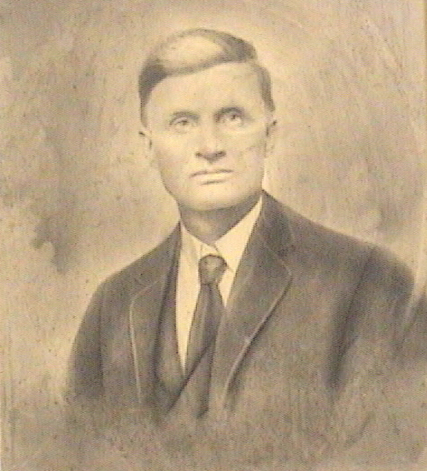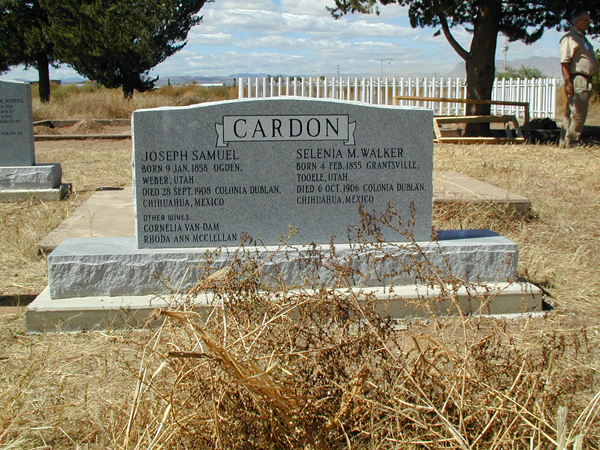9 Jan 1858 – 28 Sep 1908
Son of Philip Cardon and Martha Marie Tourn
Son of Louis Philip Cardon and Susette Stalé
Autobiography
This is a copy of a brief Autobiography written by Joseph S. Cardon on request of Andrew Jensen, Church Historian, for record in the church files, shortly before he became a member of the Dublán Bishopric about 1902. Photos added by the Cardon Families Organization.

Joseph Samuel Cardon
1858 – 1908
Joseph S. Cardon was born January 9, 1858 in Ogden, Weber county, Utah. In a sketch prepared for this work, Elder Cardon writes:
“My parents were Piedmonters, natives of Italy. My father joined the church in 1852 and emigrated to America in 1854. He started to drive a team across the plains before he could speak a word of English. My mother, whose maiden name was Susette Staley, joined the Church in 1853 and emigrated in 1856, crossing the plains in the firsthand cart company at the age of eighteen under Capt. Edmund Ellsworth. Her father gave out and died on the plains, leaving her mother, one brother two sisters and herself to complete the journey under trying circumstances. She married my father Louis Philip Cardon in the Valley as a plural wife.
They were both of the old Vardous race who never were converted to the Catholic faith, although many of them died at the stake and suffered every persecution that could be heaped upon them. My parents located in Logan when I was two years old, and five years later they moved to Oxford, Idaho, then the northern frontier of the Saints. As a boy I experienced many incidents pertaining to frontier life in an Indian country and had several ties to move in and out of forts built for protection.
I was ordained a deacon at the age of twelve by Bishop George Lake, and though a boy I sensed to a considerable degree the responsibility of that calling and tried in my weakness to magnify it. At the age of fifteen, I was ordained a Teacher and served with other brethren in the capacity of Ward Teacher. I was ordained an Elder July 23, 1874 and married the same day by Bishop George Lake.
My father was called to go with the company of Bishop Lake to settle on the Little Colorado River in Arizona, in 1876. He had started to make a home in Utah in connection with Bishop Lake and they were being persecuted for conscience sake by a political party known as the Malad Ring when President Brigham Young saw fit to call them to Arizona. My younger brother, Emmanuel P. Cardon, accompanied my father and Brother Lake to Orderville in Southern Utah, there to await the arrival of the companies; thence they traveled to the Little Colorado River where the camps established their location at a place called Camp Obed.
My brother returned the same spring to Oxford, Idaho. Sometime during the spring or summer Apostle Brigham Young, then residing at Logan, in a conversation asked me if I intended to go to Arizona. I answered that I expected to go there to assist my father to establish himself and then return to Idaho, as I did not consider I was called as an Arizona missionary. Bro. Young said, “I will call you. And I want you to go and consider yourself, together with your brother, as much missionaries as if you had been called by the President of the Church.” Had I not been thus called I would have done as many others did, left the mission as soon as I could have got away. After my brother’s return, we settled up all our business in Idaho and started October 6, 1876, for Arizona, our outfit consisting of six mules, five yoke of oxen, four heavy wagons, one single team, and a herd of sixty-five head of stock. I drove the ox team and the responsibility and incidents connected with that journey made it quite an undertaking. It took all the time ‘till Christmas to get there.
Finding our cattle worn out and our stock also, I pulled up the Moencopi wash to the fort built by our Indian missionaries during the summer and went into camp for the winter on Christmas day. While encamped there my wife gave birth to a daughter. The child died and the mother came near losing her life also. We were the first to start a graveyard in what is now Tuba City. My father and my brother came back as far as Moencopi in March 1877 to meet me and I moved to Camp Obed.
After staying there a few weeks I moved up the river and located Woodruff in connection with my father, Emmanuel P. Cardon and William Walker, my wife’s brother, who had accompanied us from Idaho. We were the first families to locate at Woodruff and were joined later by Elder Nathan Tenney and others. We could not utilize the land there until we could construct a dam some thirty feet high; consequently, we rented some land from one Mr. Stimson who owned the ranch where Snowflake now stands. The next summer we were joined by Lorenzo Hatch and others. We organized for the putting in of the Woodruff dam under the direction of a committee of which I was a member, and was appointed foreman for the work. We labored during the fall and winter and had the dam completed to within a few feet of the top when a sudden freshet came down the Little Colorado River and washed around our work, leaving it a much larger job then it was in the beginning.
It now became evident that something must be done to obtain supplies for the camp. Consequently I was called by Brother Hatch, who was then counselor to Pres. Lot Smith and presiding Elder of Woodruff, to make up an outfit of six-mule teams and go with some of the brethren to earn provisions to assist the people until we could put in the dam and take out the water. We freighted wool from the White Mountains nearby, to Elmon, near Trinidad, which was then the terminus of the railroad in the State of Colorado. The Lord greatly blessed our labors and we returned to Woodruff loaded with supplies both of food and clothing, but it being now late in the season we decided to go to some place where we could raise a crop. We accordingly went up Silver Creek about _____ miles above what is now Snowflake, where three of the brethren, James Pierce, ___________ and William Walker, had located at a place since known as Taylor.
As soon as we had become established, President Hatch, who was now counselor to Jesse N. Smith of Snowflake Stake, appointed me Presiding Elder at Taylor, and we made a Branch of Snowflake Ward under Bishop Hunt. I was also appointed chairman and foreman to build a dam and canal to take out the water at Taylor on the west side of the creek. Two years later at the organization of the Taylor Ward, I was ordained a High Priest by President Jesse N. Smith and chosen as first counselor to Bishop John N. Stanisford. I worked in this capacity until I moved to Old Mexico. At the same time I was given a special responsibility in regard to the young people, having charge of all their amusements, dances, etc.
During this time I was privileged to make a trip to the St. George Temple, which was afterwards the cause of my move to Old Mexico (Thank the Lord), at the time of the raid on those brethren who were living in the order of plural marriage, and during which time Ammon N. Tenney and others were sent to Detroit, Mich. and others to Fort Yuma, Arizona. This led to the move into Old Mexico. I started with the company from Taylor and Snowflake, Feb. 9, 1884, and on the way met the brethren from other settlements. We organized for the journey and late in March arrived on the Casas Grandes River, near the Mexican town of La Ascension and Colonia Diaz.
We remained in camp a few weeks to make arrangements to pass the Custom House, etc. during which time Apostle George Teasdale visited us. The camp was divided, part going up the river to farm some of the Mexican lands near Casas Grandes, and part remaining near Colonia Diaz. I went with the camp up the river, Brother Wallace Roundy being appointed president of the camp.
When President Lyman made his first visit to the camps, I was called to take my teams and accompany President Jesse N. Smith to bring him in from the San Jose station on the Mexican Central. In the fall I went back to Taylor and moved the rest of my family to Mexico. I was among the first Saints to locate at Colonia Juarez, and at the organization of the Juarez Ward was appointed President of the YMMIA, the first organization of that kind in the mission, and labored in that capacity several years. I also had special charge of the amusements of the young and was made a member of what was termed the Juarez Town Council, consisting of the Mission Presidency, the Bishopric and myself. At the organization of the Juarez Stake I was chosen a member of the High Council, first counselor to the Stake President of the YMMIA, D. E. Harris, and second counselor to Stake President of High Priests Quorum, Alexander F. MacDonald. I held these positions in the Stake until I was called into the Bishopric of the Dublan Ward at its organization as first counselor to Samuel J. Robinson, which position I hold at present. And during all this time I have always taken a responsible and active part in the temporal developments.”
Joseph S. Cardon died at Colonia Dublán, Chihuahua, Mexico, September 28, 1908, of Typhoid Fever.
Joseph Samuel Cardon and Selenia Mesenile Walker, Mexico Tour Handout
Colonia Dublán Memorial Cemetery, Colonia Dublán, Chihuahua, Mexico

